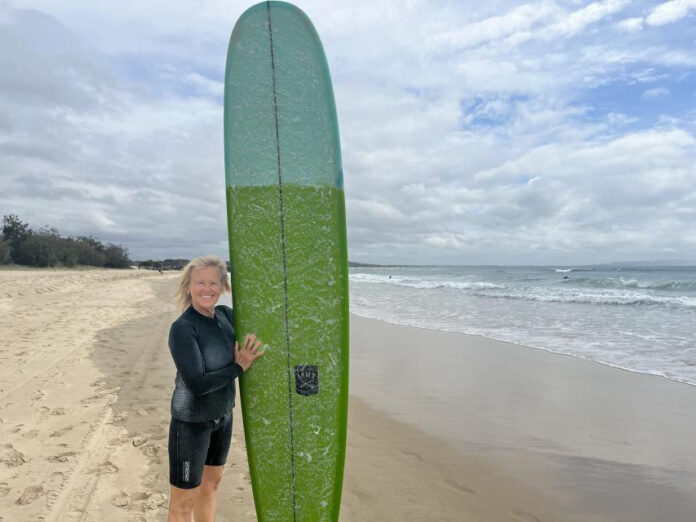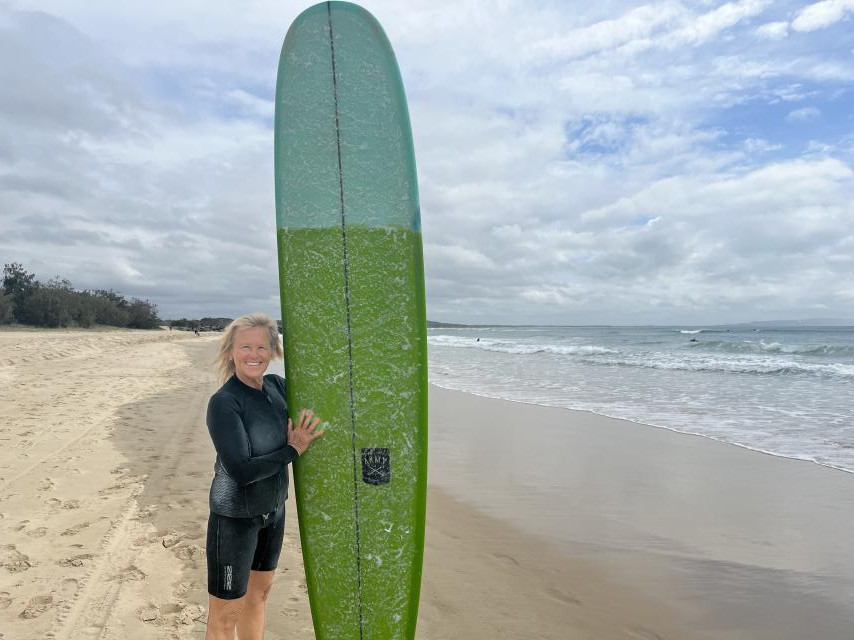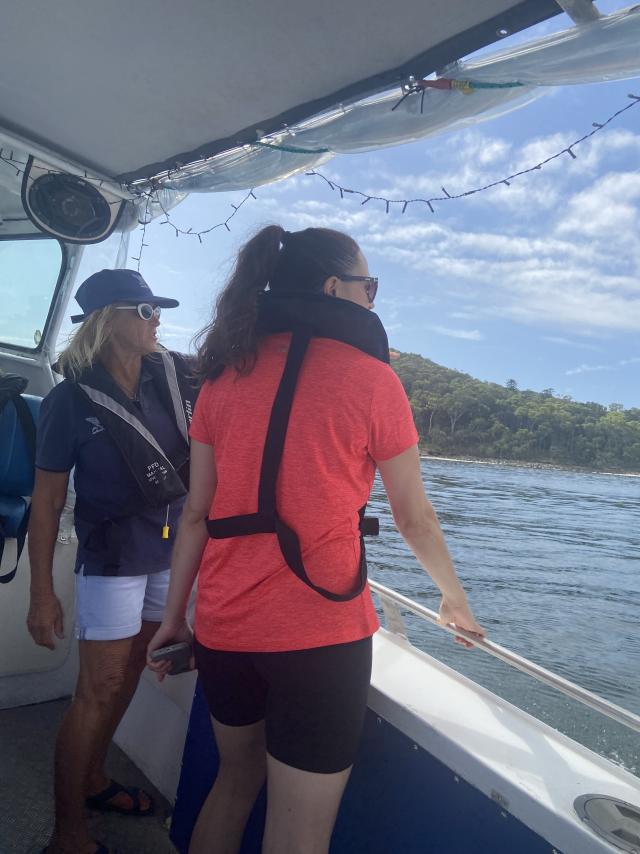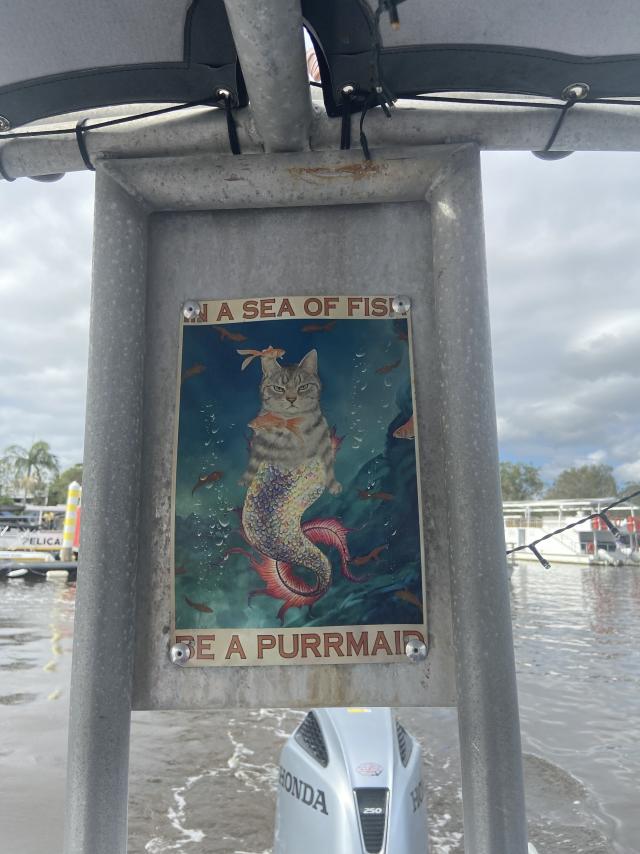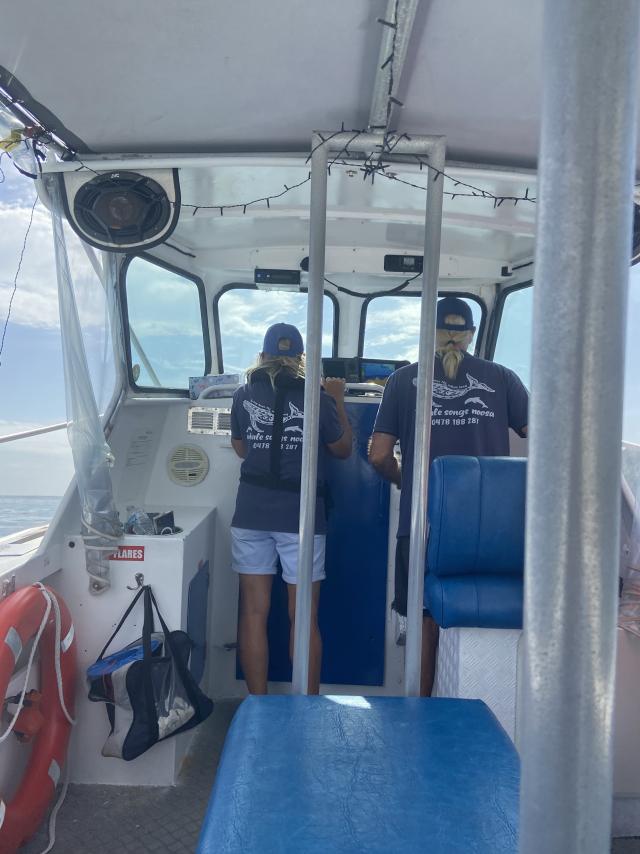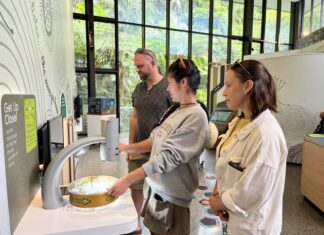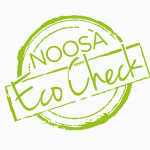Nothing could be more fitting than meeting one of the most iconic figures in Australian sport on a Noosa jetty surrounded by water. Named after a red peppercorn tree by her red-haired mother, Peppie Simpson is more than a pioneer of Australian female surfing. She is Queen of the Pacific Ocean.
“I was nearly born in the sea. My mum was on the beach when she went into labour, and I think from a very young age, the water has been my whole life, right from the very start,” Peppie said.
“I was 15 years old when I started surfing. It was 1975. When I saw these guys surfing, I was determined to do it, even though there wasn’t much encouragement from anyone.”
It was just three years later when Peppie formed the Victorian Women’s Surfing Association that became part of the national surfing body to promote women’s surfing in Australia throughout the 70s and 80s.
Winning the Respect Award (in memory of Bill Wallace) at Noosa World Surfing Reserve Community Awards in 2023 adds to her string of accolades as a multiple longboard champion.
Riding on the crest of a wave, nothing holds Peppie back at 64, as she continues to compete in the largest annual over-50s surfing competition in Australia, Noosa Malibu Club’s Wrecks and Relics.
“Surfing was really the thing that drew me to the ocean. But one day, I was given a book called ‘The Dolphin Connection’ by a lady from Hawaii named Joan Ocean, who is also a psychologist. This book moved me deeply,”
Peppie said.
The book provides an insight into human-dolphin communication based on intimate friendships formed, resulting in multi-sensory experiences, whereby the dolphin is the teacher.
“So, I write to Joan in 1995, and say, ‘I’ve got to come and meet you, be with the dolphins, and learn from you,’ Peppie said.
“I went over to Hawaii, which started a very long love of this beautiful place, and my relationship with Joan and the dolphins. I learnt so much from them and wanted to share this knowledge.”
“So, I started taking people on trips there for several years to experience the incredible gifts the dolphins share with us,” she said.
Peppie’s love for animals is as deep as the bottom of the ocean, where (according to Peppie) footage of whales singing into the earth has been recorded.
“The whole animal kingdom communicates telepathically, heart to heart. I’ve worked with one of the world’s leading animal communicators, Pea Horsley, who’s been to Noosa three times, and was here last year. She’s taught me so much about the animal kingdom,” Peppie said.
“I think for humans, it’s really a matter of trusting and understanding that they really are extraordinarily intelligent. I’ve had many, many experiences with both the whales and dolphins and many other animals to know this,” she said.
The moving documentary film, ‘My Octopus Teacher’ by Craig Foster about a unique bond formed between man and octopus springs to mind here. But that is also a stark reminder we are not alone in this ecosystem. Rescuers who freed a baby whale tangled in shark nets off Noosa in October 2023, proves this.
With the salty breeze blowing against her sun-bleached hair, Peppie reflects on the launch of her business Whale Songs Noosa she owns with partner of 16 years, surfing champion, and sea-loving captain, Albie.
“We started back in 2023 because when the world turned upside down with Covid, we couldn’t get to Hawaii. I said to Albie that I would love to do some of this work and share this knowledge with people in Noosa, so we started looking for a boat and it all began from there,” she said.
“We had an extraordinary beginning. The person who was working on our website, put the website on live before we were ready to start, just to test it, and we got all these bookings.”
“Then my husband rings me, and says, “We’ve got a charter today. We’ve got to go,” Peppie said. “And I said, what??— we’re not ready!’
It was a sixth sense that told Peppie to go with the flow, like trusting your instinct before surfing inside a barrelling wave.
“So, I go home to get ready, and on the way, I have this extraordinary feeling that something amazing was going to happen. And I tuned into this energy, and it was the whales who said: “We’re ready for you.” So, I knew we were going to see them,” Peppie said.
“We got the people on the boat, we headed out, and just got over the river mouth, and there were five big males, waiting. We took off, and we followed them, and it was like we were escorted across the bay.”
“And I said to the people on the boat that it was unusual to see whales behaving like this. We had them all around the boat. It was like that they were happy we were there,” she said.
This long-held passion for marine animals has developed into a fascination for Indigenous culture that Peppie shares onboard with honour.
Nearing coastal cliffs at Noosa National Park, we come across a point behind Sunshine Beach, which Peppie refers to as ‘Dolphin Lounge’ that holds cultural significance to Kabi Kabi peoples.
“This particular area is where I’ve observed both the whales and dolphins a lot, and I thought I really wanted to find out what this area is,” Peppie said.
“When I had an Aboriginal woman on the boat, I took her there, and I asked her about this area as there was something special about it, and she said:
‘This is a Song Line. In Aboriginal culture, a Song Line is a very special energetic piece of land. It’s where the ancient people would walk and tell the stories and sing songs,’ ”Peppie said.
“I instantly knew this connection then with the whales and dolphins because everything with them is also about sound and singing, and I found that really fascinating —that’s 80,000 years of culture and knowledge,” she said.
“I was also talking to this Aboriginal woman about the whale songs because one of the scientists I work with believes there’s only one Humpback whale song that they share all around the planet. Another scientist believes that every whale has its own unique song. But this Aboriginal woman said that most Indigenous cultures believe that the whale song actually changes every year, depending on the consciousness of the people—that’s mind-blowing,” Peppie said.
It is this deep respect for Indigenous culture that led Peppie in the 1980s to facilitate an excursion for Aboriginal children based 500kms northwest of Brisbane.
“I went up to the mission at Moorabinda with a friend of mine who did a lot of Aboriginal education and introduced me to the families,” Peppie said.
“I said I would really love to bring the children down to the ocean, because I knew that this is their land, and their area, and you know, genetically they’re connected here. So, we did, and it was very, very special.”
“Uncle Trevor, who is actually the last initiated man from this area, gifted me the Song of the Dolphins to sing them in. I still remember it, but I don’t share it very often,” Peppie said.
This appreciation for Indigenous culture has also been demonstrated with the launch of Whale Songs Noosa’s cultural tours in late November 2024.
“Our first one went amazingly well. We just stayed in the river and talked to Sam. He told us about incredible Dreamtime stories of the area, played the didgeridoo, and we did some painting and learned what the symbols meant,” Peppie said.
“We’re hoping to start them up again in the New Year and run them through to the whale season because then we’re too busy. I just love bringing that cultural knowledge in, because to me, that is where the missing link is,” Peppie said.
In addition to the sensory and cultural connections that resonate with Peppie,
it is the scientific realm, where she plays a significant role in South East Queensland.
Wearing many sun hats in the oceanic world, Peppie is also a committed member of conservation group Oceans For All Noosa.
“We’re in this group to try and remove these shark nets because they’re simply not working. They’re very old technology, and the scientists who are working with us say there’s no science, or logic, behind them,’ Peppie said.
“We’re catching way too much bycatch, including whales, dolphins, turtles and rays,” she said.
According to catch data from the Queensland Government’s database, QFish,
in the past five years, 59 dolphins, 245 turtles, 217 rays and 44 whales have been caught on drumlines and entangled in shark nets. Human Society International claims many of these animals perished, but due to the trauma involved, it is unlikely those found alive would survive after release.
In May 2024, survey results showed approximately 70 per cent of Noosans voted in favour of alternative shark control methods and the removal of nets during the whale season, whilst an independent review on the issue is due soon. A SharkSmart drone trial currently operating at Noosa Main Beach will continue until June. But Department of Fisheries must first complete its research program for shark net removal in Noosa to be considered this year.
“Sandy Bolton’s a trooper. She’s really helping us out and is very much in support of upgrading our technology, so that everything in the ocean can survive in harmony. Obviously, we want people to be safe, but we also need to have our wildlife safe as well,” Peppie said.
Peppie also collects data for the Humpback and High Rises (HHR) whale research organization based at Griffith University on the Gold Coast — the largest marine mammal monitoring program in South East Queensland.
But it is her work with University of the Sunshine Coast’s Research Fellow and Lecturer Dr Alexis Levengood that is also creating a ripple effect.
Surrounded by sparkling blue ocean, Peppie perches herself at the side of the boat, monitoring the marine environment like an ocean warrior, before turning towards her passengers.
“So, you’ll see me talking often into my phone. I’m recording data for the university and send the data sheets off. I’m recording the number of dolphins, what they’re doing, their behaviour, the temperature of the water, the wind, if there’s other boats, and the interaction between the dolphins,” Peppie said.
Focusing on studying species along the coastline, including health, behaviour, spatial, social, and genetic connectivity, dolphin research had been overlooked in the Noosa region, until Dr Alexis Levengood founded the project Dolphin Research SEQ with UniSC PhD students in 2022.
“We realised at the time there wasn’t much research going on in South East Queensland. There was quite a bit of research going on in Moreton Bay, but north of there was largely ignored. There were zero studies done along the Sunshine Coast, which still to this day, seems shocking to me,” Dr Levengood said.
“There were only about 15 studies done up in Hervey Bay region, but they were outdated. The last study done was about 15 years ago. We know about marine strandings, bycatch records, so we knew the dolphins were here. We just had no real research on who they were, what they were doing, and what was going on.”
“We’re trying to understand their connectivity in the region, meaning how spatially, socially and genetically connected they are, as well as understanding their natural predators, like sharks,” Dr Levengood said.
The dolphins in Noosa are faced with unique challenges compared with other marine environments in Queensland, with Common bottlenose, Indo-Pacific bottlenose, and Australian humpback dolphins, most observed in the area.
“We see our bottlenose dolphins most often, but sometimes, we still get humpback dolphins, which is wonderful as they’re considered vulnerable by the IUCN, and you usually see these species interact with each other also, which shows a really dynamic ecosystem in the region,” Dr Levengood said.
“I think our Noosa dolphins are quite incredible. A lot of research that’s been done globally, and especially in Australia, has been in these shallow embayments, such as Morteon Bay, Hervey Bay and Shark Bay on the West Coast. They’re all kind of really shallow, large, well-protected embayments,”
she said.
“But when we look at places like Noosa, this is open ocean that’s unprotected, with more difficult environments and conditions. These animals are thrown against more challenging scenarios in lots of ways,” she said.
“What is quite remarkable is that we see these massive pods come together in Noosa, unlike other embayments such as Hervey Bay, Moreton Bay, and others in the region. They’re all spread out, all interacting together, living this incredible, dynamic life in Noosa, that again, really, until about two years ago, nobody’s even really questioned, or asked anything about, or looked into further,” Dr Levengood said.
“So, there’s still a lot we don’t know, there’s still a lot we hope to unfold and uncover, but right now, it suggests we have a really healthy population in Noosa,” she said.
As part of her dolphin research, Dr Levengood said she hopes to publish a paper this year focusing on epidermal lesions, including studies on body conditions and toxicology.
She met Peppie Simpson at a community workshop she held in Marcoola a few years ago, where a mutual agreement to work with each other was established.
“Peppie is wonderful. She genuinely cares about the environment, and about these dolphins and whales, massively. Peppie is really, a huge advocate for these animals and for South-East Queensland marine ecosystems,” she said.
The invaluable work driving Peppie is what this marine ecosystem depends on, which is cause for inspiration to many.
“Peppie’s also one of those people who really get behind your work and support you, but you can also do the same thing, and kind of collaborate as a team, together,” Dr Levengood said.
In addition to her research at UniSC, Dr Levengood has established a Facebook site, entitled, Dolphin sighting SEQ, and is urging citizen scientists to participate in free one-day ‘Dolphin Spotter’ workshops to record vital data.
“When people finish the workshop, they’re trained to spot dolphins on their own, but also able to train friends, family, whoever’s around, and then at the end of the day, we go out to the Headlands, searching for dolphins and put into practice what we learnt in the theory component,” Dr Levengood said.
“As researchers, we can’t be everywhere all the time. So, the best way for us to learn more about what these animals are doing, and when and where they’re doing it, is getting more eyes on the water,” she said.
“Anytime you’re on the water, on a boat, walking your dog, walking at the Headlands, if you see a dolphin, let us know. The more we know about them, the more we can protect them, and our entire ecosystem that we share with these incredible animals,” Dr Levengood said.
As we approach the jetty after nearly two hours on the water, I reflect on the mantra, ‘In a Sea of Fish, be a Purrmaid’ displayed on Peppie’s boat, convinced she is the Purrmaid on a lifelong mission to change the world.
For more information on the Dolphin Spotter workshops in February and March, and to register, go to:
www.facebook.com/groups/281236564615175
To learn more about Whale Songs Noosa, log onto:
Whale Songs Noosa | Whale, Dolphin, Surf, Snorkel, Fishing & Sunset Charters Noosa

